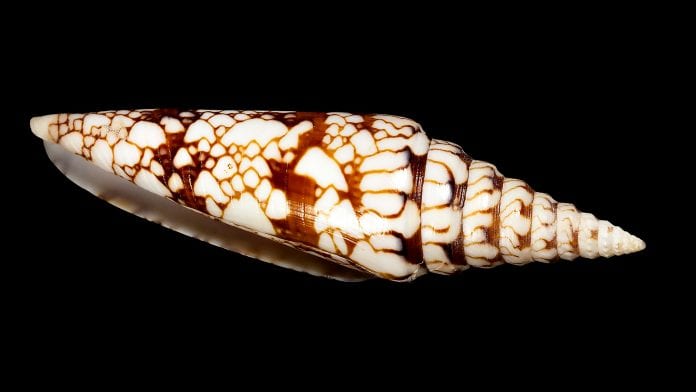
Conotoxins, found in the venom of the one of the sea’s deadliest creatures, the cone snail, have the potential to become a new class of analgesics.
Conotoxins are bioactive peptides found in the venom that marine cone snails produce for prey capture and defence. They are used as pharmacological tools to study pain signalling and have the potential to be used in pain therapy.
The benefit of conotoxins is that they are much more potent than morphine, and that they trigger no symptoms of dependence, unlike opioids.
To date, more than 10,000 conotoxin sequences have been discovered. Associate Professor Markus Muttenthaler from the Faculty of Chemistry at the University of Vienna, and his colleagues from the University of Queensland in Australia, are experts in the field of venom drug discovery and have now provided an overview on the status quo of conotoxin research in Chemical Reviews.
In another recently published study, the researchers have furthermore developed fluorescently labelled conotoxin versions to visualise pain receptors in cells.
The marine predatory cone snail is well-known for its effective envenomation strategy, which helps the relatively slow-moving animal to catch their prey, such as fish or molluscs, and to defend itself. The cone snail paralyses and kills their prey with the help of a very selective and potent cocktail of venom peptides, which is injected into prey through a harpoon-like needle.
Markus Muttenthaler, said: “Cone snails can control their venom composition depending if they hunt or defend themselves.”
“For pain research, we are particularly interested in the venom of a defending cone snail, as its composition is aimed at causing pain and its individual components can be used to study pain pathways,” the ERC Starting Grant awardee states.
High diversity of species and compounds
To date, an estimated 750 species of cone snails are known. A typical venom contains hundreds to thousands of bioactive peptides, with typical lengths of 10 to 40 amino acids.
These conotoxins display well-defined, protein-like structures, which are stabilised through multiple disulfide bond frameworks.
Conotoxins are also active on human receptors which is of particular interest, as they can be used as tools to study pain pathways in humans.
Muttenthaler said: “Conotoxins have revolutionised pain research since their extraordinary potency and selectivity enables us to study the individual subtypes of ion channels, which was not possible before.”
With the help of conotoxins, researchers can now define the physiological as well as pathological relevance of the different receptor subtypes.
One conotoxin has already received FDA-approval for the treatment of severe chronic pain. It is directly administered to the spinal cord where it specifically blocks a pain transmitting ion channel subtype.
“It is 1,000 times more potent than morphine and triggers no symptoms of dependence, which is a big problem with opioid drugs,” says Muttenthaler.
Current research focusses now on conotoxins that could already target nerve endings outside the spinal cord, which would facilitate administration.
“This would enable us to intercept the pain signal before it is transmitted into the central nervous system,” Muttenthaler added.
Using conotoxins for new methods
New analytical advances in the fields of venomics, proteomics and transcriptomics have led to the discovery of many new conotoxin sequences in recent years. The synthesis and pharmacological characterisation, however, is comparatively more time-consuming.
Conotoxins can furthermore be functionalised and provide outstanding leads for new molecular probes.
In another paper published in the Australian Journal of Chemistry, the researchers developed a new methodology to label conotoxins and use them to visualise ion channels in cells. These tools are important for a better understanding of the complex biology behind pain, which is a leading cause of disability in the world.










Wow this is interesting research. Turning poison into medicine is fascinating. Pain truly is debilitating. Currently I use a product called Absorbine Jr. and put it on my pain points. I’d rather not use OTC pain meds.
Prialt, a conotoxin drug, has been available in the US for at least five years. It was developed at the University of Utah, Salt Lake City, Utah, USA. The last time I checked, it is not covered by my insurance and evidently costs thousands of dollars per dose.
It would be wonderful if Prialt and other similar drugs could be produced in quantities that would make these drugs available to many, many more patients who suffer from intractable, incurable chronic pain.
Thanks to the scientists, engineers, researchers, and trial test subjects who ultimately make it possible for these kind of non-addictive, yet apparently highly effective medications to be developed. Now we just need pharmaceutical companies who are not out to gouge patients, nor take advantage of their desperation for relief.